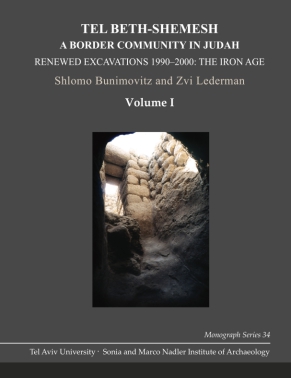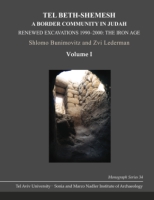
Tel Beth-Shemesh: A Border Community in Judah
Renewed Excavations 1990–2000: The Iron Age
Shlomo Bunimovitz and Tzvi Lederman
Tel Beth-Shemesh: A Border Community in Judah
Renewed Excavations 1990–2000: The Iron Age
Shlomo Bunimovitz and Tzvi Lederman
“Located in the Judahite lowlands (Shephelah), Tel Beth-Shemesh offers an intriguing story of a border town that had to adjust to the changing geopolitical situation of the region. Accordingly, the guiding theme of the publication is the phenomenon of being located on a political and cultural border.”
- Offers
- Description
- Reviews
- Table of Contents
Customers in Israel buy here.
It is no wonder that two celebrated biblical border epics—Samson’s encounters with the Philistines and the Ark narrative—took real or imagined place around Beth-Shemesh. In this report, summarizing the first ten years (1990–2000) of archaeological work in the ongoing project of the renewed excavations at Tel Beth-Shemesh, the authors have strived to tell anew the story of the Iron Age people of Beth-Shemesh as exposed and interpreted. Using the best theoretical and methodological tools that modern archaeology has made available, every effort has been made to keep in view archaeology’s fundamental duty—to read the ancient people behind the decayed walls and shattered pottery vessels and bring alive their lost world. Furthermore, the story of ancient Beth-Shemesh has been written in a way that will enable scholars, students, and other interested people to learn and understand the life of the communities living at Beth-Shemesh.
As a result, the book is organized in a manner different from usual archaeological site reports. The two volumes will be essential for anyone who wishes the best and latest information on this important site.
“Located in the Judahite lowlands (Shephelah), Tel Beth-Shemesh offers an intriguing story of a border town that had to adjust to the changing geopolitical situation of the region. Accordingly, the guiding theme of the publication is the phenomenon of being located on a political and cultural border.”
“[The authors] suggest an updated and balanced methodology of archaeology. . . . What emerges, among much else of human interest, is the significant story of how Beth-Shemesh changed in the 8th century BCE from an important government centre into an unfortified oil-producing town before suffering invasion and destruction. All future studies of Tel Beth-Shemesh will, without doubt, be greatly indebted to them.”
Part One: Introductory Essays
1. A Tale of Three Expeditions: Tel Beth-Shemesh Excavators, Excavations, and Site Reports in Context
2. Archaeology of a Border Community
Part Two: Strategy And Methodology
3. Strategy, Goals, and Stratigraphical Synopsis
4. Data Acquisition, Recording, and Management
Part Three: The Last Days of Beth-Shemesh
5. Epilogue: Water Drawers and Vicious Neighbors Level 1: Iron IIC ca. 650–635 BCE
Excursus: Petrographic Analysis of Iron II Holemouth Jars Yuval Goren
Part Four: Early Iron Age Village
6. A Peasant Community on the Philistine Border Levels 6–4: Iron I ca. 1150–950 BCE
Excursus A: Petrographic Analysis of Selected “Philistine Ware” Vessels Yuval Goren
Excursus B: Jar of Dried Figs Ehud Weiss and Yael Mahler-Slasky
7. Animal Husbandry in the Early Iron Age at Tel Beth-Shemesh Brian Hesse, Emmett Brown, and Timothy Griffith
8. Crossing the Border with Samson: Beth-Shemesh and the Bible’s Geographical Imagination Steven Weitzman
Part Five: The State at Beth-Shemesh
9. Royal Intervention: From Village to Administrative Center Level 3: Iron IIA ca. 950–790 BCE
10. The Lithic Assemblage . . . . . . Jeffrey I. Rose
11. From Village To State: Changes in the Animal Economy of Beth-Shemesh during the Iron Age Brian Hesse and Emmett Brown
Part Six: Olive-Oil Producers’ Town
12. “Your Country Is Desolate, Your Cities Are Burned with Fire:” The Death of a Judahite Border Town Level 2: Iron IIB ca. 790–701 BCE
13. A Priest’s House at Beth-Shemesh? An Incised qdš Bowl Dale W. Manor
14. Lmlk and Official Seal Impressions Andrew Vaughn
Excursus: Petrographic Analysis of lmlk and Official Sealed Jar Handles from the Renewed Excavavations Yuval Goren
Part Seven: Complementary Studies
15. Anthropomorphic and Zoomorphic Figurines and Hollow Vessels Raz Kletter
16. Iron Age Artifacts
Excursus: A Scarab of Thuthmosis III Nir Orlev
17. The Iron Age Jewelry Amir Golani
Excursus: An Inscribed Egyptian Amulet Deborah Sweeney
18. Loom Weights
19. Ḥnn Gaming Board Michael Sebbane and P. Kyle Mccarter
20. The Name “Beth-Shemesh” and the Toponomy of the Region around Tel Beth-Shemesh Ran Zadok
21. Archaeobotanical Remains Nili Liphschitz
Part Eight: Radiocarbon Studies
22. Tel Beth-Shemesh Radiocarbon Analyses: A Commentary
23. Radiocarbon Dating of the Iron Age Stratigraphic Sequence Elisabetta Boaretto, Ilan Sharon, and Ayelet Gilboa
24. Radiocarbon Dating at Tel Beth-Shemesh: A Second Look Eli Piasetzki
Part Nine: Data in Context
Main Occupational Units: Context and Contents
Layer List
Feature List
Mailing List
Subscribe to our mailing list and be notified about new titles, journals and catalogs.



